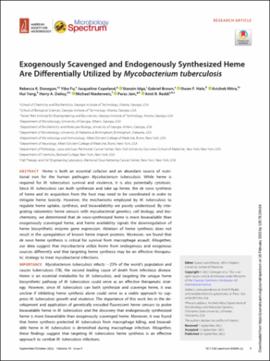| dc.contributor.author | Donegan, Rebecca K. | |
| dc.contributor.author | Fu, Yibo | |
| dc.contributor.author | Copeland, Jacqueline | |
| dc.contributor.author | Idga, Stanzin | |
| dc.contributor.author | Brown, Gabriel | |
| dc.contributor.author | Hale, Owen F. | |
| dc.contributor.author | Mitra, Avishek | |
| dc.contributor.author | Yang, Hui | |
| dc.contributor.author | Dailey, Harry A. | |
| dc.contributor.author | Niederweis, Michael | |
| dc.contributor.author | Jain, Paras | |
| dc.contributor.author | Reddi, Amit R. | |
| dc.contributor.editor | Lamichhane, Gyanu | |
| dc.date.accessioned | 2023-02-16T16:36:12Z | |
| dc.date.available | 2023-02-16T16:36:12Z | |
| dc.date.issued | 2022-10-26 | |
| dc.identifier.citation | Donegan, R. K., Fu, Y., Copeland, J., Idga, S., Brown, G., Hale, O. F., Mitra, A., Yang, H., Dailey, H. A., Niederweis, M., Jain, P., Reddi, A. R. (2022). Exogenously Scavenged and Endogenously Synthesized Heme Are Differentially Utilized by Mycobacterium tuberculosis. Microbiology Spectrum, 10(5), pp. e03604-e03622. https://doi.org/10.1128/spectrum.03604-22 | |
| dc.identifier.issn | 2165-0497 | |
| dc.identifier.uri | https://hdl.handle.net/11244/337037 | |
| dc.description.abstract | Heme is both an essential cofactor and an abundant source of nutritional iron for the human pathogen Mycobacterium tuberculosis. While heme is required for M. tuberculosis survival and virulence, it is also potentially cytotoxic. Since M. tuberculosis can both synthesize and take up heme, the de novo synthesis of heme and its acquisition from the host may need to be coordinated in order to mitigate heme toxicity. However, the mechanisms employed by M. tuberculosis to regulate heme uptake, synthesis, and bioavailability are poorly understood. By integrating ratiometric heme sensors with mycobacterial genetics, cell biology, and biochemistry, we determined that de novo-synthesized heme is more bioavailable than exogenously scavenged heme, and heme availability signals the downregulation of heme biosynthetic enzyme gene expression. Ablation of heme synthesis does not result in the upregulation of known heme import proteins. Moreover, we found that de novo heme synthesis is critical for survival from macrophage assault. Altogether, our data suggest that mycobacteria utilize heme from endogenous and exogenous sources differently and that targeting heme synthesis may be an effective therapeutic strategy to treat mycobacterial infections. IMPORTANCE Mycobacterium tuberculosis infects ~25% of the world's population and causes tuberculosis (TB), the second leading cause of death from infectious disease. Heme is an essential metabolite for M. tuberculosis, and targeting the unique heme biosynthetic pathway of M. tuberculosis could serve as an effective therapeutic strategy. However, since M. tuberculosis can both synthesize and scavenge heme, it was unclear if inhibiting heme synthesis alone could serve as a viable approach to suppress M. tuberculosis growth and virulence. The importance of this work lies in the development and application of genetically encoded fluorescent heme sensors to probe bioavailable heme in M. tuberculosis and the discovery that endogenously synthesized heme is more bioavailable than exogenously scavenged heme. Moreover, it was found that heme synthesis protected M. tuberculosis from macrophage killing, and bioavailable heme in M. tuberculosis is diminished during macrophage infection. Altogether, these findings suggest that targeting M. tuberculosis heme synthesis is an effective approach to combat M. tuberculosis infections. | |
| dc.format | application/pdf | |
| dc.language | eng | |
| dc.publisher | American Society for Microbiology | |
| dc.relation.ispartof | Microbiology Spectrum, 10 (5) | |
| dc.relation.uri | https://www.ncbi.nlm.nih.gov/pubmed/36169423 | |
| dc.relation.uri | http://dx.doi.org/10.1128/spectrum.03604-22 | |
| dc.rights | This material has been previously published. In the Oklahoma State University Library's institutional repository this version is made available through the open access principles and the terms of agreement/consent between the author(s) and the publisher. The permission policy on the use, reproduction or distribution of the material falls under fair use for educational, scholarship, and research purposes. Contact Digital Resources and Discovery Services at lib-dls@okstate.edu or 405-744-9161 for further information. | |
| dc.subject.mesh | Humans | |
| dc.subject.mesh | Mycobacterium tuberculosis | |
| dc.subject.mesh | Heme | |
| dc.subject.mesh | Bacterial Proteins | |
| dc.subject.mesh | Tuberculosis, Lymph Node | |
| dc.subject.mesh | Mycobacterium Infections | |
| dc.subject.mesh | Iron | |
| dc.title | Exogenously scavenged and endogenously synthesized heme are differentially utilized by Mycobacterium tuberculosis | |
| dc.date.updated | 2023-02-15T22:54:18Z | |
| dc.note | open access status: Green OA | |
| dc.identifier.doi | 10.1128/spectrum.03604-22 | |
| dc.description.department | Microbiology and Molecular Genetics | |
| dc.type.genre | Article | |
| dc.type.material | Text | |
| dc.subject.keywords | Emerging Infectious Diseases | |
| dc.subject.keywords | Prevention | |
| dc.subject.keywords | Tuberculosis | |
| dc.subject.keywords | Biodefense | |
| dc.subject.keywords | Orphan Drug | |
| dc.subject.keywords | Vaccine Related | |
| dc.subject.keywords | Infectious Diseases | |
| dc.subject.keywords | Rare Diseases | |
| dc.subject.keywords | Aetiology | |
| dc.subject.keywords | Biological and endogenous factors | |
| dc.subject.keywords | Factors relating to the physical environment | |
| dc.subject.keywords | Infection | |
| dc.subject.keywords | Good Health and Well Being | |
| dc.subject.keywords | Mycobacterium smegmatis | |
| dc.subject.keywords | Mycobacterium tuberculosis | |
| dc.subject.keywords | heme | |
| dc.subject.keywords | heme homeostasis | |
| dc.subject.keywords | heme sensors | |
| dc.subject.keywords | heme synthesis | |
| dc.subject.keywords | heme transport | |
| dc.subject.keywords | iron | |
| dc.subject.keywords | iron homeostasis | |
| dc.relation.oaurl | https://pubmed.ncbi.nlm.nih.gov/36169423/ | |
| dc.identifier.author | ORCID: 0000-0003-0243-2045 (Mitra, Avishek) | |
| dc.identifier.essn | 2165-0497 | |
